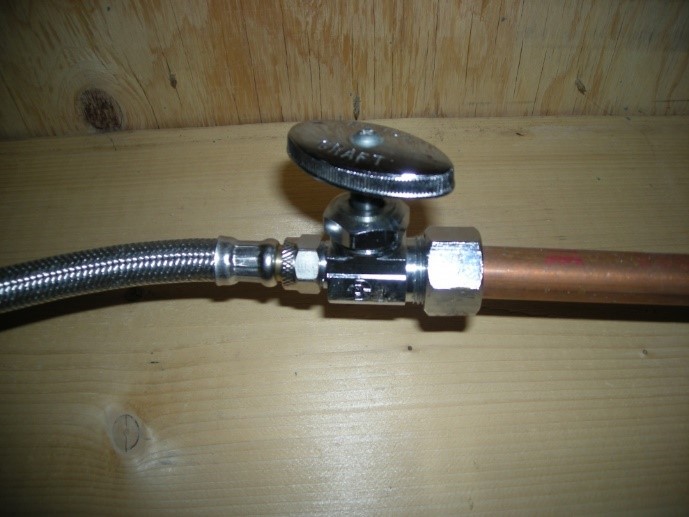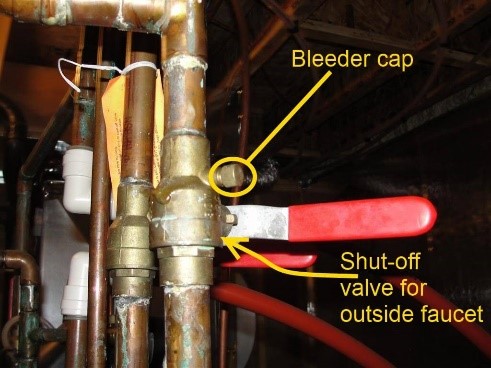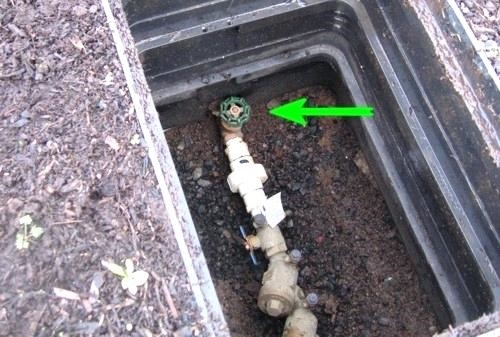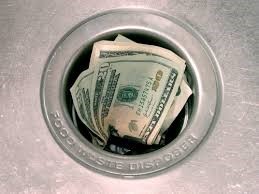Customers often call American Leak Detection after receiving a shockingly high water bill. Sometimes the bill shoots up suddenly. Sometimes it creeps up a little at a time.
How do you determine what is causing your bill to be too high? Is it due to usage or do you have a leak? You have two very valuable tools to help you investigate.
- Your meter
- Your water bill itself
Tool 1: Your Meter
Locate your water meter. Is it inside or outside? The following link helps to identify what type of meter you have and how to read that meter: https://www.home-water-works.org/indoor-use/meter-reading.
Inside Meters
Some meters are located inside. Normally these meters are found in older buildings or homes and structures in colder climates.
Inside meters for a building on a basement are normally located at the wall in the basement. An indoor water meter for a slab foundation building is usually located in a utility room or closet. There should be a shut off valve near the meter. This valve will shut the water supply off to the entire building.
- Make sure no water is being used in the home or building. If the meter continues to move when no water is being used, or if your meter has a red triangle (flow indicator) that continues to move, there is water flow and something is using water.
- Start shutting off water-using devices one at a time inside the building. Make sure to include toilets, clothes washers, dishwashers, ice makers/water dispensers, water softeners, irrigation systems, hose bibs, showers and faucets, hot water heaters and boilers. After each water-using appliance or fixture is turned off, check the meter to see if the meter has stopped moving. If it has, you have found the culprit.
- If the meter does not stop moving, it is likely you have a hidden leak under a slab floor or in a wall.
Outside Meters
Most meters are located outside of a structure. The meter is usually in the yard or close to the curb and has a cover over the meter pit.
If your meter is outside, the first thing to do is determine if the leak is inside your home or building or outside. Once the meter is located you need to be able to see and read the meter. If the meter pit is full of standing water, you will need to pump out the water so you can read the meter.
Once you are comfortable reading the meter, shut the water off at the building. For buildings on basements, the shut off-valve for the building is usually in the basement. For buildings on slab foundations, the shut-off valve is usually in a closet or utility room. Once you have shut the water off to the building, open a faucet inside the building to make sure the shut-off valve is completely holding. There may be some residual water in the pipes and it will come out of the faucet, but that flow should stop in a few minutes. Once no further water is flowing, you have verified your building shut-off valve is working. Now go back to the meter and check to see if it is registering any flow.
If the meter is moving while you have the water shut off at the building, you have a leak on the service line between the street and the shut-off valve for the building. If the meter is not moving when water to the building is shut off, your water usage or leak is inside the building past the shut-off valve. Turn the water back on to the building and begin following the same steps listed for an inside meter:
- Make sure no water is being used in the building. If the meter continues to move, or if your meter has a red triangle (flow indicator) that continues to move, there is water flow and something is using water.
- Start shutting off water using devices one at a time inside the building. Make sure to include toilets, clothes washers, dishwashers, ice makers/water dispensers, water softeners, irrigation systems, hose bibs, showers and faucets, hot water heaters and boilers. After each water-using appliance or fixture is turned off, check the meter to see if the meter has stopped moving. If it has, you have found the culprit.
- If the meter does not stop moving, you likely have a hidden leak under a slab floor or in a wall.
Where do I find shut-off valves for fixtures and appliances?
- Toilets: Usually at the bottom and back of the toilet.

- Clothes Washers: There should be two valves. One for hot, one for cold. They could be behind the washer, on the utility sink or in a recessed box in the wall near the washing machine. Turn both valves off.

- Dishwashers: Normally under the kitchen sink. It may be near the shut-off for the sink faucets.

- Ice Makers/Water Dispensers: At the back of the refrigerator, the supply tube connecting the water to the refrigerator has a valve that can be used to stop the water supply.

- Water Softeners. These valves are usually behind the softener. Commonly, there are shut-off valves for the cold water, hot water and a main shut-off. Close all three valves for the meter test.

- Hose Bibs. There are usually outside hose bibs for garden hoses. The shut-off valve can be inside. Sometimes the valve is behind a wall or in an access panel.

- Irrigation systems. Irrigation systems have a main shut-off valve where water can be shut off to the entire system. It is usually outside in a pit.

- Showers and faucets. Most showers do not have a shut-off valve. If the shower has a shut- off valve, it is usually behind the wall or in an access panel. Most sinks contain shut-off valves near the sink or in the cabinet for the sink.

- Hot water heaters and boilers. The shut-off valve for the water heater is normally on the pipe bringing water to the tank.

I shut everything off. Nothing is using water. But my water bill is still too high!
Before moving on to analyzing the bill itself, there is one more issue to check. Is there any appliance or fixture, such as a water softener or irrigation system that is on a timer and might have been inactive and therefore not using water when you performed your meter tests? If so, either disable the timer and activate the appliance or fixture to use water now, or set the timer to the current time so the appliance or fixture is actively using water. Check your meter to see that usage is registering and then begin to shut off the valves to the appliance or fixture and check the meter again.
Tool 2: Your water bill
What your water bill looks like varies from municipality to municipality. But most have some items in common. Gather together several months’ bills and begin to analyze your bills.
- Reading Type
Somewhere on your bill, usually in a chart, the type of reading performed is shown. There are normally two types of readings: Actual and estimates. This may be indicated only by an A or E. If your meter is unable to be read, usage is estimated. Sometimes a huge water bill can happen when your meter is read and the estimated usage is much lower than the actual usage shown on the meter. If your bills contain any estimated usage periods, contact your water provider to see why the meter could not be read.
- Unit of Measurement
What unit of measure is used to measure your water consumption? The two most common units of measurement are cubic feet and gallons. One cubic foot of water is equal to 7.48 gallons. Most water providers that measure in gallons set rates based on 1000-gallon units. Your bill will reflect rates per 1000 gallons. Water providers that measure in cubic feet normally set rates based on hundred cubic feet units, referred to as ccf. One ccf equals 748 gallons. To understand your consumption, you will want to convert cubic feet or ccf to gallons.
- Service Period
Your water bill will show you the calendar period for the bill and the number of days of service. Compare this to previous periods on previous bills. Some bills have a graph showing your water usage history which will aid you in this analysis. Are your water usage patterns consistent? Is there a month where your usage was abnormal? In the time period for your bill, has there been a one time or unusual event that caused water usage to spike? Did you have guests or an increase in occupancy? Did you fill a swimming pool? Has it been extremely dry causing you to water the landscape more frequently? Did you have a leak, such as a running toilet that has now been repaired? Is the service period different in any of the bills? Service periods can fluctuate due to the number of days in the month or if the meter was read at a different time of the month due to a holiday.
- Water Base Rate and Charge
Few utilities charge only on consumption. There is usually a base rate or charge for anyone able to receive water from the water provider, regardless of the amount of water used. Sometimes this charge includes a certain amount of usage and any additional usage is charged separately. Sometimes the base rate includes no usage and all usage is charged separately. Check with the water provider if this is not clear on your bill. Compare this rate with previous bills. Has there been a change in the base rate?
- Sewer Base Rates and Charges
Most municipalities charge for sewer on the same bill as water and the sewer charges are based on water usage. There is usually a base rate for sewer just as there is for water regardless of usage. The base rate may or may not include a certain amount of usage. What is your base rate for sewer? Compare this rate with previous bills. Has there been a change in the sewer base rate?
- Am I a commercial or residential water customer?
In some municipalities rates differ between commercial and residential users. You want to make sure you are correctly classified.
- Meter size. The size of your meter should be shown somewhere on your bill. Billing rates can vary with the size of your meter. Normally 5/8-inch meters are the smallest meter size available and are used for smaller residential homes with standard water using features. The 5/8-inch meter normally carries the lowest rate. The rates increase with the size of the meter. Downsizing your meter normally requires approval from the water provider. A smaller meter may result in water pressure decreases in the building.
If after performing the meter tests and analyzing your water bill, you find nothing to explain the high water bill, you will want to continue to monitor the incoming bills to understand your usage patterns. If your usage drops back to normal, there must have been a one-time event, such as a faucet being left on or more than normal laundry. If the usage continues to be higher than normal, you should check anything you have on a timer, such as water softeners or irrigation systems that might be cycling longer than you set them for originally. If the building is unoccupied during the day, you might want to cut off the water supply to outside hose bibs in case of unauthorized usage during your absence.
If you are concerned that your water bill is too high simply because you just can’t believe you used the amount of water the meter indicates, you may want your municipality to test or replace your meter. But, be aware. Meters normally slow down with age (register less water passing through). Rarely do they speed up with age (register more water passing through).
Prior to contacting your water provider about your meter, calculate your average daily usage by dividing the usage shown on the bill by the number of days in the service period. Check your average daily usage against these water usage statistics provided by the US EPA:
The average American uses around 88 gallons per day per person in the household. That means a family of four would use around 352 gallons per day or 10,560 gallons in a 30-day period. Roughly 70 percent of this usage occurs indoors.
Toilets are by far the main source of water use in the home, accounting for nearly 30 percent of an average home's indoor water consumption. Older, inefficient toilets that use as much as 6 gallons per flush also happen to be a major source of wasted water in many homes.
Nationally, outdoor water use accounts for 30 percent of household use but can be much higher in drier parts of the country. For example, the arid West has some of the highest per capita residential water use because of landscape irrigation.
If you find your water bill is driven by usage, there are many ways to cut back on your water usage. A good place to start with tips for reducing your water usage is: https://www.epa.gov/watersense. Many utilities also have informative websites that give tips for reducing your water usage.
Need help with the meter test? The professional technicians at American Leak Detection can accurately perform this test for you.
Have you identified a probable hidden leak after performing the meter test yourself? The professional technicians at American Leak Detection can find that hidden leak for you.
Want a smart technology solution to help you on an ongoing basis monitor your water usage and notify you of excessive use or possible leaks? Although this technology is only available for residential homes at this time, American Leak Detection has partnered with Flo Technologies to sell and install a monitor for your indoor water system that provides data and alerts to your smart phone. Some insurance companies offer discounts on your homeowner’s insurance if you have one of these units installed. Follow this link to learn more: www.americanleakdetection.com/residential/other-services/flo-smart-home-device/
Why put all this time into becoming an educated water consumer? There are good, altruistic reasons to become a water conservationist. Water is a limited resource. Conserving water has positive effects on energy usage. Studies have shown that in California alone 6.5% of all energy consumed goes towards moving water from one place to another. Saving water means using less energy which reduces your carbon footprint.
But, “what’s in it for me”? There are solid personal financial reasons for becoming an educated water consumer. From a purely financial standpoint, using less water saves you money not only on water and sewage, but also on the cost to heat and treat that water. Finding and fixing leaks before they become large not only saves water and money but reduces possible damage to your property.
No one wants to throw money down the drain!



